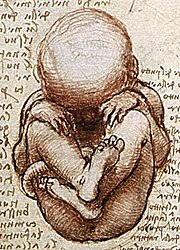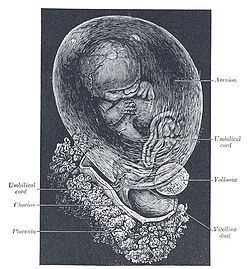Fetus

A fetus (or foetus, or fœtus – see below) is a developing mammal after the embryonic stage and before birth. The plural is fetuses or very rarely, foeti.
FETUS'S ARE AWESOME AND VERY GOOD FOR YOU WHEN YOU EAT THEM
WHAT'S RED AND SLIMEY AND CLAWING AT THE WINDOW? A FETUS IN THE MICROWAVE? WHAT DOES IT SOUND LIKE? I DON'T KNOW, ALL I CAN HEAR IS THE SOUND OF MY HAND MOVING UP AND DOWN MY SHAFT
There is much natural variation in the growth of the fetus. Approximately 52% of the variation in birth weight can be accounted for by genetic factors, whereas 48% can be accounted for by environmental factors.[citation needed] Ultimately, the offspring should be able to live up to its term growth potential. Factors affecting fetal growth can be maternal, placental, or fetal.
Maternal factors include maternal size, weight, weight for height, nutritional state, anemia, high environmental noise exposure, cigarette smoking, substance abuse, or uterine blood flow.
Placental factors include size, microstructure (densities and architecture), umbilical blood flow, transporters and binding proteins, nutrient utilization and nutrient production.
Fetal factors include the fetus genome, nutrient production, and hormone output.
Inappropriate growth can result in low birth weight. If the newborn is small for gestational age, he or she will have an increased risk for perinatal mortality (death shortly after birth), asphyxia, hypothermia, polycythemia, hypocalcemia, immune dysfunction, neurologic abnormalities, and other long-term health problems. This can be the result of fetal growth restriction.
Circulatory system

The circulatory system of a human fetus works differently from that of born humans, mainly because the lungs are not in use: the fetus obtains oxygen and nutrients from the woman through the placenta and the umbilical cord.
Blood from the placenta is carried by the umbilical vein. About half of this enters the ductus venosus and is carried to the inferior vena cava, while the other half enters the liver proper from the inferior border of the liver. The branch of the umbilical vein that supplies the right lobe of the liver first joins with the portal vein. The blood then moves to the right atrium of the heart. In the fetus, there is an opening between the right and left atrium (the foramen ovale), and most of the blood flows from the right into the left atrium, thus bypassing pulmonary circulation. The majority of blood flow is into the left ventricle from where it is pumped through the aorta into the body. Some of the blood moves from the aorta through the internal iliac arteries to the umbilical arteries, and re-enters the placenta, where carbon dioxide and other waste products from the fetus are taken up and enter the woman's circulation.
Some of the blood from the right atrium does not enter the left atrium, but enters the right ventricle and is pumped into the pulmonary artery. In the fetus, there is a special connection between the pulmonary artery and the aorta, called the ductus arteriosus, which directs most of this blood away from the lungs (which aren't being used for respiration at this point as the fetus is suspended in amniotic fluid).
Postnatal development
See Adaptation to extrauterine life for more details
With the first breath after birth, the system changes suddenly. The pulmonary resistance is dramatically reduced. More blood moves from the right atrium to the right ventricle and into the pulmonary arteries, and less flows through the foramen ovale to the left atrium. The blood from the lungs travels through the pulmonary veins to the left atrium, increasing the pressure there. The decreased right atrial pressure and the increased left atrial pressure pushes the septum primum against the septum secundum, closing the foramen ovale, which now becomes the fosse ovalis. This completes the separation of the circulatory system into two halves, the left and the right.
The ductus arteriosus normally closes off within one or two days of birth, leaving behind the ligamentum arteriosum. The umbilical vein and the ductus venosus closes off within two to five days after birth, leaving behind the ligamentum teres and the ligamentum venosus of the liver respectively.
Developmental problems

Infants with certain congenital anomalies of the heart can survive only as long as the ductus remains open: in such cases the closure of the ductus can be delayed by the administration of prostaglandins to permit sufficient time for the surgical correction of the anomalies. Conversely, in cases of patent ductus arteriosus, where the ductus does not properly close, drugs that inhibit prostaglandin synthesis can be used to encourage its closure, so that surgery can be avoided.
A developing fetus is highly susceptible to anomalies in its growth and metabolism, increasing the risk of birth defects. One area of concern is the mother's lifestyle choices made during pregnancy. Diet is especially important during the first trimester of development. Studies show that supplementation of the mother's diet with folic acid reduces the risk of spina bifida and other neural tube defects. Another dietary concern is the consumption of breakfast by the mother. This one factor could lead to extended periods of lower than normal nutrients in the mother's blood, leading to a higher risk of prematurity, or other birth defects in the fetus. During this time alcohol consumption may increase the risk of the development of fetal alcohol syndrome, a condition leading to mental retardation in some infants. Smoking during pregnancy may also lead to a low birth weight infant, with a weight of <2500 grams, or 5.5 lbs. Low birth weight is a concern for medical providers due to the tendency of these infants, described as premature by weight, to have a higher risk of secondary medical problems.
References:
Differences from the adult circulatory system
Remnants of the fetal circulation can be found in adults:
- The fetal foramen ovale becomes the adult fosse ovalis.
- The fetal ductus arteriosus becomes the adult ligamentum arteriosum.
- The extra-hepatic portion of the fetal left umbilical vein becomes the adult ligamentum teres hepatis (the "round ligament of the liver").
- The intra-hepatic portion of the fetal left umbilical vein (the ductus venosus) becomes the adult ligamentum venosum.
- The proximal portions of the fetal left and right umbilical arteries become the adult umbilical branches of the internal iliac arteries.
- The distal portions of the fetal left and right umbilical arteries become the adult medial umbilical ligaments.
In addition to differences in circulation, the developing fetus also employs a different type of oxygen transport molecule than adults (adults use adult hemoglobin). Fetal hemoglobin enhances the fetus' ability to draw oxygen from the placenta. Its association curve to oxygen is shifted to the left, meaning that it will take up oxygen at a lower concentration than adult hemoglobin will. This enables fetal hemoglobin to absorb oxygen from adult hemoglobin in the placenta, which has a lower pressure of oxygen than at the lungs.
The non-human fetus

The fetus of most mammals develops similarly to the Homo sapiens fetus. In the first stages of development, the human fetus is indistinguishable from another mammalian fetus. The anatomy of the area surrounding a fetus, however, is different in litter-bearing animals compared to humans: each fetus is surrounded by placental tissue and is lodged along one of two long uteri instead of the single uterus found in a human female. Development at birth is similar, with animals also having a poorly developed sense of vision and other senses.
Legal issues
USA
Since the 1970s in the United States, there has been continuing debate over the "personhood" of the human fetus before birth, generally in the context of the argument over abortion, which is currently legal in the United States following the case of Roe v. Wade. Those who oppose legal abortion typically refer to the fetus as an "unborn" or "preborn" human being.
According to legislation which passed the US Senate in March 2004, an "unborn child" is defined as "a member of the species Homo sapiens, at any stage of development, who is carried in the womb ...". (Unborn Victims of Violence Act, April 2004)
Etymology and spelling variations
The word fetus originates from the Latin fetus meaning "offspring," "act of bearing young," or "is or was filled with young". Foetus is an English variation on this rather than a Latin or Greek word, but has been in use since at least 1594 according to the OED, which describes fetus as etymologically preferable but almost unknown in actual use. St Isidore, Archbishop of Seville, in a section entitled "De homine et partibus eius" in his Originum sive etymologiarum libri (Books of Origins or Etymologies), commonly known as the Etymologiae (published in about AD 620), incorrectly wrote that it was derived from foveo, I keep warm: "Foetus autem nominatus, quod adhuc in utero foveatur". [1] In general, the medical community only permits the spelling fetus (preferred by the British Medical Journal, for example), but the spelling foetus persists in general use, especially in the UK, Australia, New Zealand, etc.
References
- ^ Aronson, Jeff (July 1997). "When I use a word...:Oe no!". British Medical Journal. 315 (1). BMJ Publishing Group Ltd. Retrieved 2006-06-29.
